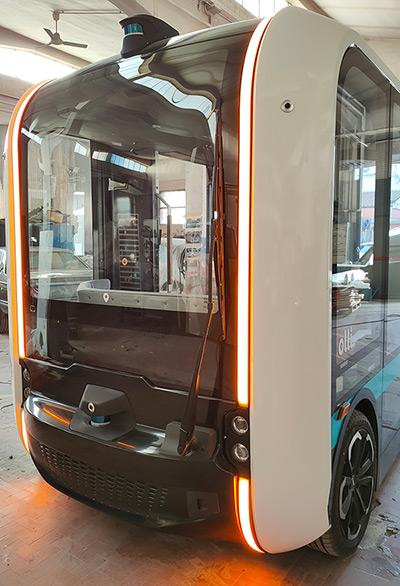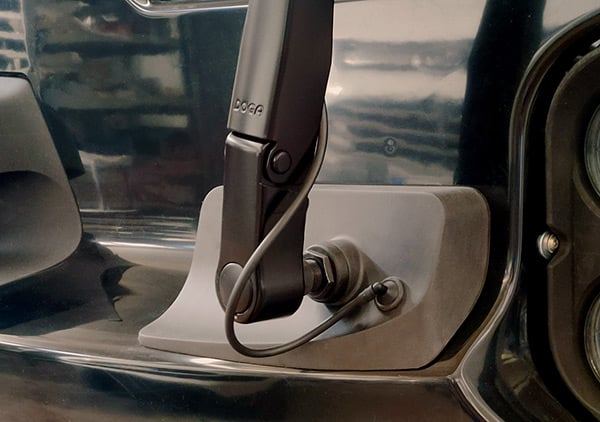
How CRP Technology developed and printed sustainable parts for the Olli 2.0 shuttle.

February 3, 2022 - Chandler, Ariz.-based ground mobility company Local Motors uses next-generation manufacturing processes to build its autonomous electric vehicle, Olli. For example, Olli’s upper and lower structures are 3D printed from recyclable polycarbonate material. 3D printing technology is an environmentally friendly manufacturing process itself. Using additive manufacturing, you can reduce transportation costs and print to match demand, with warehouses holding less stock.
With this in mind, industry-leading 3D printing has been used by the automotive developer to support a project in Europe, based on the integration of some extra parts. The production materials are from the Windform Top-Line range of composites for 3D printing.
These materials were chosen for their mechanical characteristics, but it is also important to note that the matrix of some Windform material is a bio-based polymer and therefore 100 percent renewable: The tenet, that Olli is one of the most sustainable vehicles on the road, is safe.
Regarding the Local Motors’ project in Europe, Carlo Iacovini, General Manager EMEA Local Motors, stated, “To approve deployments in Europe, it needed some additional components, not required in the US market.” Among these were windshield wipers and parts.
“To add the wiper, we opted for a retrofit technique, or re-adaptation process, through an integration on the 2.0 model,” Iacovini said. “These phases—retrofit and integration—were carried out in Italy, based on the original design produced by the Engineering Team in Chandler.”
Olli 2.0’s unique design is characterized by a tall rectangular pod with wide-set headlights and expansive windows nestled between a frame. For that reason, the wiper arm could not be positioned from above, but rather from below and to the side of the front window. “Thus, the Local Motors’ engineering department designed a new front bumper with brackets for fixing both the wipers starter motor and the front wiper-washer reservoir,” Iacovini said.
During the wipers assembly phase, the Local Motors engineering team noticed that the motor protruded from the modified front bumper: “To avoid the issue we therefore thought to add two coordinated covers,” Iacovini said: One cover conceals the protruding part while the second cover protects the pressure system of the washer reservoir from external agents, he explained.

The Local Motors team designed the motor cover from scratch. “For the wiper’s washer reservoir flap valve, we modified and adapted the design of the flap valve of the charging socket on Olli 2.0’s rear bumper,” Iacovini said. “In this way we maintained homogeneity from the design point of view, and we positioned the water flap valve symmetrically to the charging one.”
For the construction of the parts, Local Motors turned to us at 3D printing solutions provider CRP Technology and our patented Windform composite materials. The combination of laser sintering and advanced composites allows the manufacturing of production-grade 3D printed parts, achieving optimal results in terms of quality and strength, and in a short time.
CRP Technology manufactured both parts using the selective laser sintering 3D printing process and two Windform materials: the polyamide-based, carbon fiber reinforced Windform XT 2.0 for the wipers starter motor cover, and the polyamide-based, glass fiber reinforced Windform LX 3.0 for the washer reservoir flap valve.
Both parts have aesthetic as well as functional purposes. For example, the main function of the wipers starter motor cover is aesthetic, but considering its position—next to the motor—it has to: guarantee electromagnetic compatibility, resist the oscillating movement of the wiper arm and blade, withstand the continuous stress and vibrations caused by the traffic circulation on roads, and protect the electrical unit from external agents. For these reasons, the part needed to be made of a material that would provide stiffness and strength combined with high lightness, ensuring the creation of an accurate, reliable and durable application.

After manufacturing the parts, CRP Technology carried out the final tests and delivery. Then a Local Motors’ supplier installed them on Olli without encountering any mounting and fixing issues. Afterward, Local Motors conducted electromagnetism tests on the modified Olli in the anechoic chamber. The EMC testing produced excellent results. No critical issues were found in regard to the 3D printed parts made with Windform composites.
EDITOR’S NOTE: As we went to press, Local Motors announced it was closing its doors—for reasons outside of the purview of its AM work with CRP Technologies. We salute their groundbreaking work and expect other future-looking autonomous EV developers to learn from their story.

